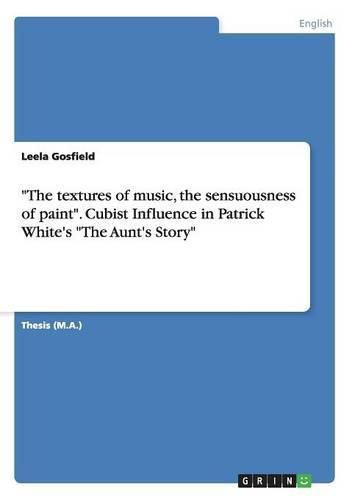Readings Newsletter
Become a Readings Member to make your shopping experience even easier.
Sign in or sign up for free!
You’re not far away from qualifying for FREE standard shipping within Australia
You’ve qualified for FREE standard shipping within Australia
The cart is loading…






Thesis (M.A.) from the year 2014 in the subject English Language and Literature Studies - Literature, grade: First Class Honours, course: Bachelor of Arts (English Literature), language: English, abstract: This dissertation analyses the influence of Cubism on Patrick White’s 1948 novel, The Aunt’s Story. Overlaying Cubist techniques, ideologies and methods a new level of meaning can be unearthed. It starts with a consideration of the combined factors that caused societal upheaval at the onset of the 20th century. The emergence of new technologies, scientific techniques and expanding schools of thought were social progressions that led to the popularisation of Cubism, literary Modernism and the dissection of the self through psychoanalytical theory. These ideas all embrace themes of fragmentation at their forefront, reflecting the splintered world that White experienced in Australia and abroad between the Wars. White’s attitude towards Freudian and Jungian schools of psychoanalysis is examined as well as his feelings about the importance of intuition. His travels, both geographically and spiritually, are seen to run in parallel with those of Theodora Goodman, the protagonist of The Aunt’s Story. The influence of Cubism on White’s narrative style, formation of character and poetics is examined within the Modernist zeitgeist to explore the similarities in artistic ideologies, both visually and technically, between White and artists. Some of these artists were his contemporaries, such as Roy de Maistre, while others affected him from afar, like ‘fathers of Cubism’ Pablo Picasso and Georges Braque. Similarities between The Aunt’s Story and key paintings reflecting White’s narrative are highlighted through a close analysis of the text in relation to plates by seminal Cubist artists. Focusing on the Cubist techniques of reconstruction and deconstruction, dimension, perspective, simultaneity, collage and fragmentation, The Aunt’s Story’s fractured narrative is a superla
$9.00 standard shipping within Australia
FREE standard shipping within Australia for orders over $100.00
Express & International shipping calculated at checkout
Thesis (M.A.) from the year 2014 in the subject English Language and Literature Studies - Literature, grade: First Class Honours, course: Bachelor of Arts (English Literature), language: English, abstract: This dissertation analyses the influence of Cubism on Patrick White’s 1948 novel, The Aunt’s Story. Overlaying Cubist techniques, ideologies and methods a new level of meaning can be unearthed. It starts with a consideration of the combined factors that caused societal upheaval at the onset of the 20th century. The emergence of new technologies, scientific techniques and expanding schools of thought were social progressions that led to the popularisation of Cubism, literary Modernism and the dissection of the self through psychoanalytical theory. These ideas all embrace themes of fragmentation at their forefront, reflecting the splintered world that White experienced in Australia and abroad between the Wars. White’s attitude towards Freudian and Jungian schools of psychoanalysis is examined as well as his feelings about the importance of intuition. His travels, both geographically and spiritually, are seen to run in parallel with those of Theodora Goodman, the protagonist of The Aunt’s Story. The influence of Cubism on White’s narrative style, formation of character and poetics is examined within the Modernist zeitgeist to explore the similarities in artistic ideologies, both visually and technically, between White and artists. Some of these artists were his contemporaries, such as Roy de Maistre, while others affected him from afar, like ‘fathers of Cubism’ Pablo Picasso and Georges Braque. Similarities between The Aunt’s Story and key paintings reflecting White’s narrative are highlighted through a close analysis of the text in relation to plates by seminal Cubist artists. Focusing on the Cubist techniques of reconstruction and deconstruction, dimension, perspective, simultaneity, collage and fragmentation, The Aunt’s Story’s fractured narrative is a superla